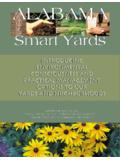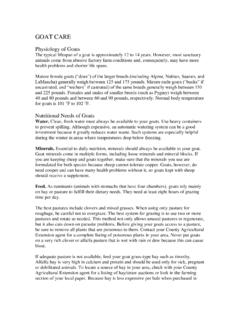Transcription of Trail Maintenance Manual 2-7 - americantrails.org
1 REVISEDT railMaintenanceManual7th Edition, RevisedNew York-New Jersey Trail Conference, Individual MaintainerTrails Maintenance AssignmentsPatrolling4 How muchWhenSpecial SituationsReporting6 Clearing8 Equipment ListStandards and MethodsBlazing15 Equipment ListStandardsOther Types of BlazingMethodsSignsProtecting the Trails27 Treadway RehabilitationIncompatible UsesEducating Hikers34 Insurance35 Environmental Monitoring37 INTRODUCTIONTHE INDIVIDUAL MAINTAINERThe New York-New Jersey Trail Conference wasformed in 1920 to coordinate the efforts of walkingorganizations in the States of New York and NewJersey, and to build and maintain trails and shelters inthese states. The Conference is dedicated to keeping each Trail in itscharge easily passable, clearly and consistently marked,in a safe condition, and harmonious with its surround-ings.
2 As an individual Trail maintainer, you havevolunteered to assist the Conference in its most impor-tant mission, and you have become responsible for:Patrollingyour Trail section a minimum of two times a conditions, work accomplishments andproblems a minimum of two times a year in Trail of natural obstructions and Trail according to Conference Trail from erosion and about Trail use and only reward will be our thanks and knowing thata job well done allows others to share the pleasures of Maintenance ASSIGNMENTSC onference trails are assigned both to its memberclubs, for sub-assigning to their individual qualifiedmembers, and to qualified individual Conference members. To be an individual Trail maintainer, youmust be either a member of the New York-New JerseyTrail Conference itself, or a member of a club thatmaintains Conference-assigned trails.
3 Throughout thismanual, individual maintainers, club-affiliated or unaffiliated, will be referred to as maintainers. If you are a maintainer affiliated with a member club,you will be supervised by and report to your club sTrails Chair, who, in turn, reports to the Conference-designated supervisor for the region encompassingyour Trail segment. If you are an unaffiliatedConference member, you will be supervised by andreport to the Conference-designated regional supervi-sor. Throughout this Manual , supervisor will refer toeither of these supervisor is responsible for assigning your trailsegment, teaching you the basic skills, and monitoringyour performance. Any problems or requests shouldbe addressed to your supervisor, who, in turn, will convey them, if necessary, to the appropriateConference authorities.
4 Under no conditions should anindividual Trail maintainer assume responsibility forany Trail or part thereof that has not been explicitlyauthorized by a Conference supervisor. The perform-ance of all maintainers and supervisors is monitored2 Introductionand evaluated by the area Trails Chair. Trail sectionsthat are not reliably maintained in accordance with thestandards prescribed in this Manual will be in maintainer assignments and supervisoryresponsibilities are also reviewed and approved by thearea Trails handle Trail projects that require more labor andexperience, the Conference has regional Trail Crews,each with a crew chief. These Trail Crews work year-round on Trail rehabilitation/construction projectsidentified and targeted by the Trails Committeesthrough the input of the individual maintainers, supervisors, park employees and the public at maintainers are also invited to contact theirregional Trail Crew through their supervisor to request help for major problems.
5 Please recognize thatthere may be a waiting list, with priorities set by theTrails for any reason you find that you cannot continueproper Maintenance of your Trail , please notify yoursupervisor. We appreciate your efforts and understandthat continuing as a maintainer may not be must know, however, when a Trail is not being maintained so that we may assign another MUCHI ndividual Trail maintainers are usually assigned onlyas much Trail as can be comfortably cleared in a on terrain and density of vegetation, thisdistance is anywhere from 2 to 5 miles. If the mileageyou have been assigned is too much or too little,inform your Patrol as soon as possible in the spring and after theleaves are down in the Patrol in midsummer if your Trail has sections of high grass, brambles or heavy undergrowth.
6 Trailsopen to the sky will require more Maintenance thanthose in mature forests with high canopies. Pathsthrough open meadows and swamps need late summerclearing. Check for blazes obscured by Patrol more frequently if heavy use and litter areproblems, or if the Trail is on private land. Sheltersattract Patrol as soon as possible after severe storms, fires,or periods of heavy SITUATIONSP rivate land:If a Trail crosses private land, it is espe-cially important to preserve the good will of the may be necessary for you to make more frequenttrips to keep the Trail open and litter-free. Any specialrequests from the owner ( , to close the Trail duringhunting season) should be referred to your trails:Separate trails occasionally merge and follow the same route before dividing again.
7 Throughyour supervisor, contact the other maintainer(s) of ajoint Trail to establish a mutually agreeable system for patrolling and maintaining such sections. The standards for blazing joint trails are set forth on page 22, item though you may find little or no clearing, blazingor litter pick-up to perform on your regular patrol, youare still performing an invaluable service: monitoringtrail conditions. The Conference must have current and reliable information for hikers. Consequently, it isimperative that you complete the Conference TrailMaintenance Report Form and return it to your super-visor each spring and fall by the specified deadline. Thisis perhaps the least glamorous part of your volunteercommitment, but it is an integral and essential forms will be provided to you by your super-visor.
8 You may also find them online at the TrailConference s web site, should keep a Trail Maintenance diary or log inwhich you record dates, locations, conditions, workdone, time spent and work pending. Such a documentwill help refresh your memory when it comes time tocomplete your Trail reports. The number of hoursspent on the Trail is an important piece of informationrequested on the report form. Aggregate volunteerhours are used to document the extent of our activities. This information is particularly importantfor obtaining governmental support, private funding,and insurance :These log books are used to record Trail -user comments and to compile Trail -use figures. Theinstallation and upkeep of authorized register boxesare the responsibility of the local Trail box replacement costs will be books are provided by the Trail provide pencils.
9 Forward completed regis-ter books to the Conference office, and replaceregister boxes that are missing or a fresh, objective look at the Trail each time youventure out. Use the standards given in this Manual as well as your common sense to judge the physicalcondition and aesthetic appeal of your Trail . Always bealert for ways to improve the the Trail for possible hiker safety issues, such ashazardous trees, confusing or missing blazes, loose orbroken components of bridges or other structures,winter ice conditions, etc. If necessary, report theseissues to your LISTS elect the equipment you will need for a specific out-ing from this list (see illustrations).Pack:for carrying other gloves:Should have at least a leather palm forcomfort and lopping shears [1]:Pruning shears forlimbs over 1/2-inch diameter; 24-inch handles arelighter and suitable for most tasks; 30-inch handlesprovide more leverage and require less saw [2]:For large branches and blowdowns; 24-and 36-inch blades will suffice for most saw [3]:10-inch for most pruning style is very whip [4]:Long-handled, scythe-like tool with 12-inch serrated blade, to be swung through vegetation atground level; before using, replace nuts with lock-nuts,or use Loctite or a similar compound.
10 Keep two handson the handle at all times. Do not use near other pruning shears [5]:Keep handy for thin branches,stalks and bags:for litter; heavy duty is s tape:For temporary [2][3][4][5][1]Axes are not recommended for routine Trail mainte-nance. Power tools fall within the province of theTrail Crews, NOTthe individual Trail and toothed tools are more effective, less tiring,and much safer if they are kept sharp. STANDARDS AND METHODSI deally, hikers should find a path cleared to a width of4 feet and a height of 8 feet. They should be able towalk with backpacks without touching surroundinggrowth. This width allows side growth of approximately1 foot before needing a Trail receives little use by backpackers, thesemeasurements may be adjusted downward, with yoursupervisor s prior you are working alone, you will find that it is difficultto lop, clear blowdowns, blaze and pick up litter all onone trip.





